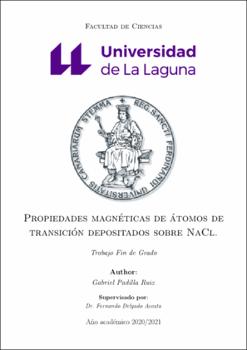Propiedades magnéticas de átomos de transición depositados sobre NaCl
Autor
Padilla Ruiz, GabrielFecha
2021Resumen
Magnetic domains are at the core of most data storage technologies. Material science is
fundamental in the design of new devices, with a continuous search for devices with smaller domain sizes, which enables higher storage density, together with new protocols for more efficient
manipulation. The route for new materials and implementation can be more efficiently addressed in a bottom-up approach, where optimal atomic species, crystal structures, and stackings
are analyzed systematically. Thin insulating layers act as stabilizers of the magnetic domains,
which suffer the impact of interactions such as phonon scattering, electronic scattering with
nearby metals, or the interaction with the probe tunnel current. With this idea in mind, in this
work, we study the magnetic properties of some transition metal atoms, usually employed in
magnetic domains, deposited on an atomically thin insulating layer of NaCl, a substrate that
has been used by some experimental groups in the search for alternative and viable technologies. With the aid of an electronic multiplet calculation, which allows us to treat precisely
the essential electronic correlations in the d-shell of the transition metal atom, we describe
the magnetic degrees of freedom of the local spins of isolated impurities. The analysis of the
spectral properties permits us to describe essential properties, such as the magnetic anisotropy,
the energy scale responsible of the stabilization of the magnetic moments versus thermal or
quantum fluctuations. We first use cobalt as a model adatom, and we use it to explore the
robustness and limitations of our results. The analysis of structural and absorption properties
is beyond the scope of the present work. Thus, it should be understood as a guide for future
and more elaborate studies, concentrating just on the possible adatoms which could display
the most advantageous magnetic properties. The results are then extended to other transition
metal atoms such as Fe or Ni.





